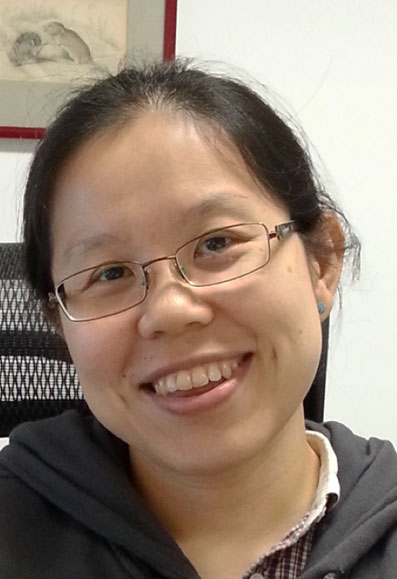
Affiliations
Principal Investigator, Institute of Medical Biology, A*STAR
Adjunct Assistant Professor, Department of Biochemistry, Yong Loo Lin School of Medicine, NUS.
Education
| Degree and Institution | Year(s) |
| Ph.D, University of California, San Diego | 2006 |
| B.Sc (First Class Honors), National University of Singapore | 2000 |
Professional Experience
| Position and Institute | Year(s) |
| Principal Investigator, Institute of Medical Biology, A*STAR | 2017- present |
| Adjunct Assistant Professor, Department of Biochemistry, Yong Loo Lin School of Medicine, NUS | 2017 – present |
| Junior Principal Investigator, Institute of Medical Biology, A*STAR | 2013 – 2017 |
| Senior Research Fellow, Institute of Medical Biology, A*STAR | 2008 – 2013 |
| Research Fellow, Genome Institute of Singapore, A*STAR | 2006 – 2008 |
Research Interest
Unique chromatin landscapes present in different cell types facilitate the cell-specific expression of genes that define cellular phenotypes and functions. As stem/progenitor cells differentiate, reversible modifications are made to the chromatin to allow for changes in gene expression. My research centers on understanding gene regulatory mechanisms that influence cell fate decisions during embryonic development and extending parallels of these pathways to cancer progression. Our studies have led to the identification of regulatory factors that control lineage specification and proliferation of embryonic cells at various stages of development e.g. the epiblast/primitive endoderm specification in blastocysts, mesodermal differentiation during gastrulation, and teratocarcinoma formation.
At present, the lab is focused on investigating the major principles of how changes in chromatin dynamics influence cell identity specification during embryonic development. Using the developing mouse epidermis as a model, we aim to identify and functionalize novel chromatin-associated factors that regulate epidermal stem cell proliferation and differentiation during normal ageing, wound healing as well as in squamoproliferative skin disorders. On-going projects include genomic approaches to delineate the chromatin landscapes of epidermal progenitor cells and functional assays to characterize transcriptional and epigenetic regulators involved in the specification of different skin cell types such epidermis, hair follicle and dermal papilla.
Selected Publications
- Chou, A.M, Sem, K.P., Lam, W.J, Ahmed, S. and Lim, C.Y. (2017) Redundant functions of I-Bar family members, IRSp53 and IRTKS, are essential for embryonic development. Sci Rep. 7: 40485
- Lim, C.Y., Knowles, B.B., Solter, D., Messerschmidt, D.M. (2016) Epigenetic control of early mouse development. Curr Topics in Dev Biol 120: 311-360.
- Lim, C.Y.,*Solter, D., Knowles, B.B., and Damjanov, I. (2015) Development Of Teratocarcinomas And Teratomas In Severely Immunodeficient NOD.Cg-PrkdcscidIl2rgtm1Wjl/Szj (NSG) Mice. Stem Cells Dev 24(13): 1515-1520 * Corresponding author.
- Piatti, P., Lim, C.Y., Nat, R., Shue, Y.T., Villunger, A., Geley, S., Soratroi, C., Moser, M., Fassler, R., and Lusser, A. (2015) Embryonic stem cell differentiation requires full length Chd1. Sci Rep. 5: 8007
- Young, T., Poobalan, Y., Tan, E.K., Tao, S., Ong, S., Wehner, P., Schwenty-Lara, J., Lim, C.Y., Sadasivam, A., Lovatt, M., Wang, S.T., Ali, Y., Borchers, A., Sampath, K., and Dunn, N.R. (2014) The PDZ domain protein Mutated in Colorectal Cancer (Mcc) is a novel effector of non-canonical Wnt signaling during convergence and extension in zebrafish. Development 141: 3505-3516
- Avery, S., Hirst, A., Baker, D., Lim, C.Y., Alagaratnam, S., Skotheim, R.I., Lothe, R.A., Pera, M.F., Colman, A., Robson, P., Andrews, P.W., and Knowles, B.B. (2013) BCL-XL Mediates the Strong Selective Advantage of a 20q11.21 Amplification Commonly Found in Human Embryonic Stem Cell Cultures. Stem Cell Reports 1: 379 – 386
- Lim, C.Y.,* Reversade, B., Knowles, B.B., and Solter, D. (2013) Optimal histone H3 to linker histone chromatin ratio is vital for mesodermal competence in Xenopus. Development 140: 853-860 *Corresponding author.
- Goh, A.M., Lim, C.Y., Chiam, P.C., Li, L., Mann, M.B., Mann, K.M., Menendez, S., Lane, D.P. (2012) Using targeted transgenic reporter mice to study promoter-specific p53 transcriptional activity. Proc. Natl Acad. Sci. USA 109 (5): 1685-1690
- Thiesen, J.W.M.*, Lim, C.Y.,* and Kadonaga, J.T. (2010) Three key subregions contribute to the function of the downstream RNA polymerase II core promoter. Mol Cell Biol 30: 3471-3479 * Co-first.
- Lorthongpanich, C., Solter, D., Lim, C.Y. (2010) Nuclear reprogramming in zygotes. Int’l J. Dev. Biol. 54 (11-12): 1631-1640
- Lim, C. Y., Tam, W. L., Zhang, J., Ang, Y.S., Jia, H., Lipovich, L., Ng, H.H., Wei, C.L., Sung, W.K., Robson, P., Yang, H., and Lim, B. (2008). Sall4 regulates distinct transcription circuitries in different blastocyst-derived stem cell lineages. Cell Stem Cell 3: 543-554
- Tam, W. L., Lim, C. Y., Han, J., Zhang, J., Ang, Y. S., Ng, H. H., Yang, H., and Lim, B. (2008). Tcf3 regulates embryonic stem cell pluripotency and self-renewal by the transcriptional control of multiple lineage pathways. Stem Cells 26: 2019 – 2031
- Konev, A. Y., Tribus, M., Park, S. Y., Podhraski, V., Lim, C. Y., Emelyanov, A. V., Vershilova, E., Pirrotta, V., Kadonaga, J. T., Lusser, A., and Fyodorov, D. V. (2007). CHD1 motor protein is required for deposition of histone variant H3.3 into chromatin in vivo. Science 317: 1087-1090.
- Lim, C. Y., Santoso, B., Boulay, T., Dong, E., Ohler, U., and Kadonaga, J. T. (2004). The MTE, a new core promoter element for transcription by RNA polymerase II. Genes Dev 18: 1606-1617.

